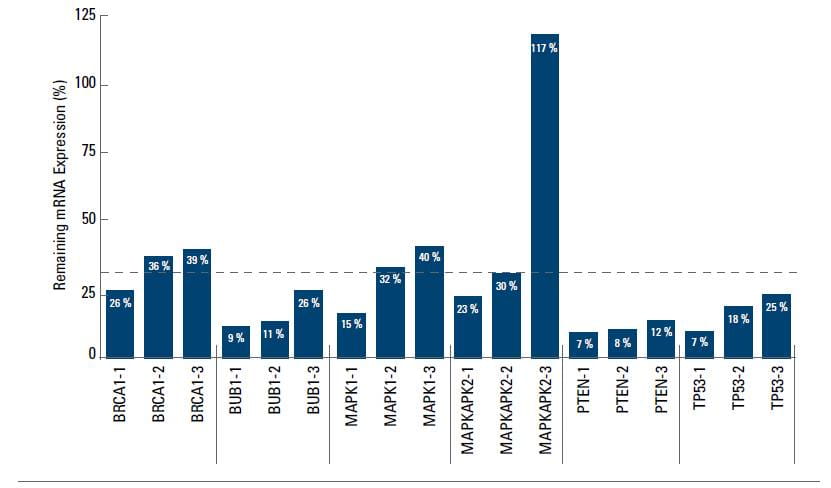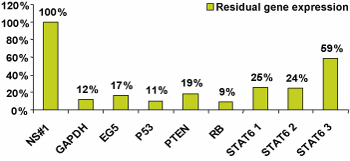GIPZ Lentiviral shRNA
microRNA-adapted shRNA based on miR-30 for specific gene silencing with minimal cytotoxicity

GIPZ Lentiviral shRNA
1Start Here
2Choose
The GIPZ microRNA-adapted shRNA collection was developed in collaboration with Gregory Hannon and Steve Elledge at Cold Spring Harbor Laboratories (CSHL). GIPZ shRNA designs are based on native miR-30 primary transcript to enable processing by the endogenous RNAi pathway and result in specific gene silencing with minimized cellular toxicity.
Highlights
- microRNA-adapted shRNA for specific knockdown
- TurboGFP marks cells expressing shRNA
- Genome-wide human and mouse representation
- Lentiviral delivery extends RNAi to primary and non-dividing cells
- Generation and maintenance of stable cell lines facilitated by puromycin selection marker
Pre-designed human and mouse GIPZ shRNA designs are available as bacterial glycerol stocks or high-titer lentiviral particles. Search for your gene(s) of interest to find
- Individual shRNA constructs, supplied as E. coli glycerol stocks or high-titer lentiviral particles (1x108 TU/mL, ± 20%, functional titer obtained by flow cytometric analysis of transduced GFP-positive HEK293T cells)
- shRNA Starter Kits which include positive and negative controls, plus delivery reagent
- Target Gene Sets comprised of 3 to 6 GIPZ shRNA constructs
*One out of three GIPZ Lentiviral shRNA is guaranteed to produce gene knockdown by ≥ 70% at the mRNA level when used in shRNA Starter Kit. Knockdown should be compared to non-silencing control and experimental workflow must be controlled using the provided GIPZ GAPDH positive control.
GIPZ Lentiviral shRNA Starter Kits
The GIPZ Lentiviral shRNA Starter Kits combine the versatility of lentiviral shRNA, the convenience of experimental controls and the necessary mode of delivery for RNAi experimentation.- Your choice of GIPZ lentiviral shRNA constructs targeting human or mouse genes
- Positive and negative GIPZ lentiviral shRNA controls
- Kits for delivery of GIPZ shRNA by transfection or transduction
- Lentiviral particle starter kits provided as 2 x 25 µL aliquots of each gene-targeting construct, 1 x 25 µL aliquots of each control
- Guaranteed knockdown when at least 3 GIPZ shRNAs are tested following protocols and using the included GIPZ shRNA positive and negative controls
The GIPZ Transduction Starter Kit includes:
- Three GIPZ shRNA as E. coli glycerol stock cultures
- Trans-Lentiviral packaging mix sufficient for 10 packaging events
- Calcium phosphate transfection reagent
- Positive and negative GIPZ lentiviral shRNA controls‡
- Guaranteed knockdown† when at least 3 GIPZ shRNAs are tested following protocols and using the included GIPZ shRNA positive and negative controls
The GIPZ Lentiviral shRNA Transfection Starter Kit with DharmaFECT kb includes:
- Three GIPZ shRNA as E. coli glycerol stock cultures
- Positive and negative GIPZ lentiviral shRNA controls
- DharmaFECT transfection reagent for delivery of shRNA plasmid
- Guaranteed knockdown† when at least 3 GIPZ shRNAs are tested following protocols and using the included GIPZ shRNA positive and negative controls
Transduction-ready high-titer lentiviral particle format reduces time, labor, and costs involved in prepping DNA, packaging and purifying lentiviral particles for your RNAi experiments. Concentrated, high-titer lentiviral particles allow multiple experiments in a variety of cell types requiring variable multiplicity of infection (MOI). Lentiviral particles are provided at titers of 1x108 TU/mL, ± 20%, functional titer obtained by flow cytometric analysis of transduced GFP-positive HEK293T cells).
Please note that due to the inherent complexity of high-titer lentiviral particle production, we estimate a 6 to 8 week turnaround time.
† When you purchase a minimum of three shRNA to the same target, at least one of the shRNA constructs will reduce target mRNA levels by 70% or more when used with Starter Kit protocols and normalized for delivery efficiency. Delivery conditions should be confirmed using appropriate positive controls provided in the kit and the percent-knockdown should be compared to cells using the negative control (non-targeting) shRNA.
Note that the GIPZ Lentiviral shRNA and TRIPZ Inducible Lentiviral shRNA are not compatible with third generation packaging systems, such as ViraPower from Invitrogen. We recommend the Trans-Lentiviral Packaging System to general lentiviral particles for transduction of GIPZ and TRIPZ shRNA.
When you purchase a minimum of three shRNA to the same target, at least one of the shRNA constructs will reduce target mRNA levels by 70% or more when used with Starter Kit protocols and normalized for delivery efficiency. Delivery conditions should be confirmed using appropriate positive controls provided in the kit and the percent-knockdown should be compared to cells using the negative control (non-targeting) shRNA.
shRNA Controls
GIPZ Lentiviral shRNA Controls
- Validated collection of GIPZ positive and negative controls for a well-designed RNAi experiment.
- Available as glycerol stocks or viral particles.
pGIPZ vector elements

Figure 1.
Effective knockdown using GIPZ lentiviral shRNA

Figure 2. OVCAR-8 cells were transduced with GIPZ lentiviral shRNA constructs at MOI = 0.4 to2 in 2 to 4 biological replicates. Cells were puromycin-selected (30 μg/mL) starting 48 hours post-transduction. RNA was isolated 84 hours posttransduction.
qPCR was performed in triplicate via TaqMan � Gene Expression Assays using 18S rRNA as an internal reference. On average, two out of three shRNA produced greater than 70% knockdown compared to the GIPZ Non-targeting Control shRNA.
Knockdown efficiency of GIPZ lentiviral shRNA

Figure 3. HEK293T cells were transduced with lentiviral particles containing shRNA to GAPDH, eG5, p53, Rb, or STAT6. Non-silencing shRNA was transduced as a control. The graph depicts the residual levels of these genes normalized to their equivalent non-silencing control.
TurboGFP expression in transduced cells

Figure 4. TurboGFP expression from the pGIPZ vector allows measurment of transfection and transduction efficiency. It also effectively marks shRNA expression in target cells. (A) HEK293 cells 48 hrs post-transduction and (B) the corresponding phase image.
Protocols
Safety data sheets
Selection guides
Technical manuals
Related Products
Critical to any gene silencing experiment, RNAi controls enable accurate interpretation for reliable results.
